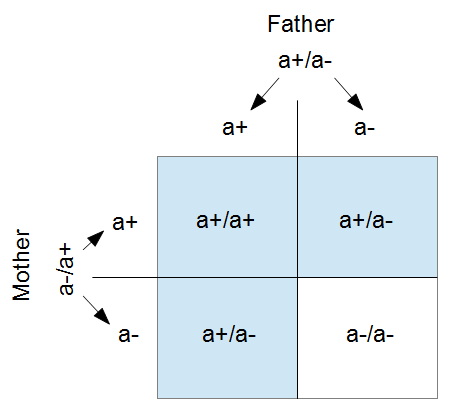In my genetics class we start off with Punnett squares as a tool to generate the relative numbers of expected offspring from a cross. In the simplest form we have two alleles at a single gene. If there is a simple dominant/recessive phenotype pattern it can illustrate why we expect a three to one ratio of offspring phenotypes from a cross between two heterozgytoes (individuals that have two different types of alleles).
One of the nice things about working with yeast in the lab is that you can grow it as a haploid (only one copy of each gene) or as a diploid (two copies of each gene); the cells grow and divide in either form. There are two mating types of cells, like male and female types in animals. In yeast the mating types are MATa and MATα, or a and α (alpha) for short. If cells of the two different mating types are growing near each other they will attempt to cross and create a diploid cell.
I used this as one of the introductory lab exercises in my genetics class. We grew haploid wildtype (white colonies) and haploid mutant cells on a plate of media. The mutants cannot produce adenine and are dark red because of oxidation of a precursor compound (in the adenine biosynthesis pathway) that accumulates in their cells.
I tried this out first and plated the mutant and wildtype haploid cells for each mating type a and α. Then after these had grown overnight I spread the cells over each other in four spots corresponding to each cross. Three of these diploid offspring cells turned (mostly) white, the dominant phenotype, and one was red because it had two mutant copies of the gene; illustrating the 3:1 phenotype ratio.
Above and below I've added genotype labels to try to illustrate. Right and left are reversed but compare the image below to the Punnett square at the top of this post.
And below is a cross plate that one of the student groups (they work in groups of four in the lab) made. It shows the heterozygotes being dominantly white colony phenotype even clearer than in my plate.
